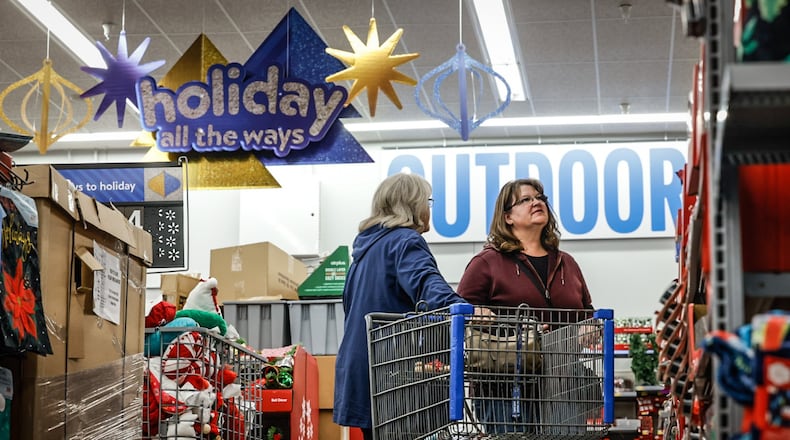“While consumers are feeling the pressure of inflation and higher prices, and while there is continued stratification with consumer spending and behavior among households at different income levels, consumers remain resilient and continue to engage in commerce,” NRF President and CEO Matthew Shay said.
Credit: Jim Noelker
Credit: Jim Noelker
JoJo Fraizer of Centerville said she and her family from Columbus will be spending the day together shopping on Friday.
“We’ve kind of put it on hold because of COVID-19 in past years. This year we’re getting out there to mainly spend time together and if we find some gifts, that will be great,” Fraizer said.
The National Retail Federation is forecasting retail sales during November and December will grow between 6% and 8% over 2021 to between $942.6 billion and $960.4 billion. Last year’s holiday sales grew 13.5% over 2020 and totaled $889.3 billion, exceeding previous records. Holiday retail sales have averaged an increase of 4.9% over the past 10 years, with pandemic spending in recent years accounting for considerable gains, according to the National Retail Federation.
Holiday spending is important for stores as Ohio’s retail industry accounts for 18 percent of the state’s Total GDP, and supports 1.5 million jobs — or one in four of all Ohio jobs, more than any other industry.
The National Retail Federation said it will be watching railway labor negotiations, and the organization called on Congress to help the industry avoid a labor strike, alluding to concerns about potential supply chain issues.
Inflation, workforce shortages, and supply chain issues remain the three biggest concerns for retails, said Gordon Gough, president and CEO of the Ohio Council of Retail Merchants.
“The railway issues are very, very important,” Gough said. “If there is a strike, that would definitely have an impact on supply chain issues.”
Additional supply chain issues could be exacerbated by diesel shortages. The U.S. has about 26 days of supply on hand, according to data from the Energy Information Administration in the week ending on Nov. 11, which is up from the low of the just over 25 day supply the U.S. had in October. While those figures are low, the U.S. typically has around a 30-day supply of fuel. This also does not account for ongoing fuel production.
While there were severe supply chain issues last year, Gough said, the outlook for available products on hand is better this year.
Forecasts are also lower than previous years during the pandemic for retail shoppers, as previous holiday sales increased 9.3% in 2020 and 13.5% in 2021. With the National Retail Federation forecast an increase between 6-8%, retailers are anticipating that consumers will be purchasing more services as gifts instead of items, so sales increases are not expected to be as high as previous percentages during the pandemic.
“I’m cautiously optimistic. I think the numbers are going to be up,” Gough said. “This a great time of year for Ohioans and Americans.”
The Greene Town Center in Beavercreek is expecting a busier shopping season this year than the last two years of the COVID-19 pandemic, with many retailers preparing early hours for Black Friday.
“I think it’s going to be more exciting. I think the public wants to get out,” said Jerry Weller, general manager of the Greene. He advised shoppers to research the Black Friday hours for the retailers they’re looking to go to on Friday.
“It’s still a big, big shopping day,” Weller said.
Online shopping provides convenience, but in-person shopping creates a different experience.
“You get to experience the community in the place where you live by shopping here,” Weller said. “I think it’s good to get out with other people … When it’s shipped to you, there’s really no experience.”
Gift givers are already hitting stores online and in-person to relieve the pressure of Christmas shopping, local store managers said.
“I think it’s already started to be different,” Tracey Evans, store manager of the Beavercreek Walmart, said about holiday shopping. “I think our customers are trying to be proactive.”
Credit: Jim Noelker
Credit: Jim Noelker
While the Black Friday shopping experience has changed, customers are still going out on Black Friday for the tradition. Walmart experiences a couple different waves of shoppers on Black Fridays now, Evans said. Some shoppers come right when the doors open, while others come later in the day, knowing there will still be a number of items from which to choose.
“I remember being a kid and my parents sitting around the Thanksgiving table, looking at all of the ads,” Evans said. “Black Friday was always the thing, and it’s still obviously that popular day and people still carry those traditions on, but as a retailer, Walmart has said we want to provide that in all of November.”
Brim, a local hat shop selling women’s, men’s, and gender-neutral hats, manages a strong presence online, as well as downtown at 464 E. Fifth St. in Dayton. The business has already seen an uptick in orders, and they frequently draw customers to Dayton from across the state and region to experience their brick-and-mortar location.
“We’ve seen a pretty significant increase in online orders,” said Emmatt James, assistant manager at Brim. “We pack them right here in store ... We try to make it as personable as possible.”
The 2nd Street Market, which is located year-round at 600 E. Second St. in Dayton, is also looking forward to a healthy shopping season. Lynda Suda, market manager at the 2nd Street Market, said the market is the place where people go after Thanksgiving to get out of the house but have a relaxed Black Friday shopping experience.
“We’re hoping to have a nice local shopping season,” Suda said. “We’re filling in all available spaces as much as we can ... We’re going to have a pretty vibrant market.”
About the Author




